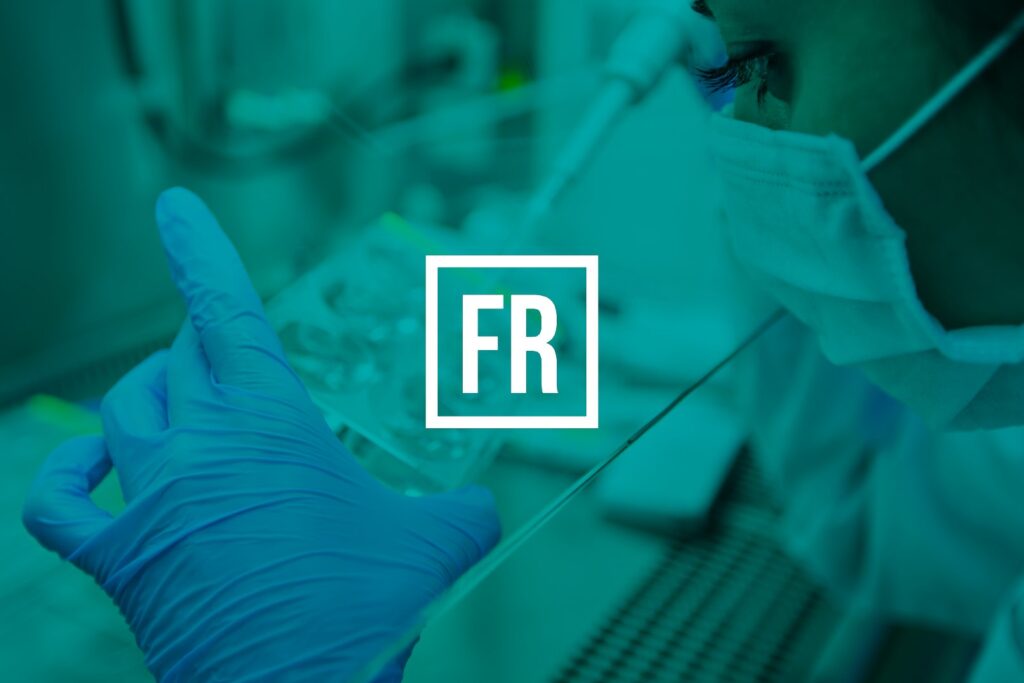What is PGT-A?
Preimplantation genetic testing for aneuploidy (PGT-A) is a test to screen embryos, which have been made in an IVF cycle, for chromosomal abnormalities. Generally speaking, embryos identified as having chromosomal abnormalities are considered abnormal or aneuploid and are not recommended for transfer. If no abnormality is detected, the embryo is presumed to be normal or euploid. In this way, PGT-A results are used to decide which embryos should or shouldn’t be transferred. PGT-A is sometimes referred to by its old name, ‘PGS’ (‘S’ for screening).
Chromosomal abnormalities are the most common cause of IVF failure, and their incidence increases dramatically with female age, assuming women are using their own eggs.
PGT-A is a controversial test, which the Human Fertilisation and Embryology Authority (HFEA), the UK’s fertility regulator, has classified as an ‘add-on’. This means that they don’t believe there is sufficient evidence yet to justify its routine use for most patients in IVF. The key word here is ‘routine’ – the HFEA do not currently provide a position on whether PGT-A may benefit some patients – for example, older women (1).
Why might you consider using PGT-A as part of your treatment?
Let’s start with what PGT-A cannot do. It cannot improve embryo quality, detect specific genetic changes (for example those causing genetic disease such as thalassemia) or increase chances of success if all of your embryos will eventually be transferred anyway (so-called cumulative pregnancy or cumulative live-birth rate).
However, there is evidence that as a selection tool, PGT-A can reduce the chances of miscarriage, support the use of single embryo transfer and reduce the time to pregnancy (by transferring the ‘normal’ embryos sooner), thus potentially saving you time, money and heartache.
How does it work?
Your embryos are grown in the usual way until around day 5 or 6 (the blastocyst stage) when a small number of cells (between 5 and 10) are removed from the embryo (a technique known as embryo biopsy) for analysis. Meanwhile the remaining embryo is vitrified (frozen) and stored for later use in a frozen embryo transfer cycle (FET). The biopsied cells are sent to a testing laboratory that generally uses DNA sequencing technology to identify the average number of chromosomes present in the sample. While the technology itself is very accurate, it is important to understand that the cells biopsied are only an approximation of the whole embryo – PGT-A analyses 5-10 cells from a blastocyst containing around 100 cells, and there is a chance that the cells analysed may not be representative of the whole embryo. Most advanced PGT-A tests available today deliver very similar results and, in my experience, how the clinic and testing laboratory work together can have more impact on the quality of the results than small differences in technology.
Who might be recommended for PGT-A?
The best evidence suggests that patients most likely to benefit from PGT-A are those of advanced maternal age (usually defined as >35 years). Other reasons for testing include patients with a history of poor outcomes such as miscarriage, severe male factor infertility and repeated IVF failure – while the evidence is less robust for these categories than for advanced maternal age, some patients may benefit. If you are considering PGT-A, or if your clinician has suggested PGT-A, it is important that you understand how the test is relevant for you and the reason for performing the testing.
What are the risks?
There are no risks to you directly as a patient (other than those present for IVF in general). However, there is a risk that you may have fewer or no embryos available for transfer if some or all embryos are reported as abnormal. If these embryos were incorrectly reported as abnormal (false positives) there is a chance that you would discard a potentially normal embryo. In recent years, the widespread reporting of mosaicism (a situation in which the sample appears to consist of a mixture of normal and abnormal cells) may have led to an increase in false positives. However, with better understanding, new clinical evidence and the support of genetic counsellors, the chance of discarding ‘normal’ embryos has dramatically reduced to around 2%.
As with any laboratory procedure, there is also a small chance that your embryo could be damaged during the biopsy, but this risk varies according to the skill and experience of the embryologist. There is also a small chance that the lab provides no result for one or more of your embryos. This is usually because the cells taken from the embryo were not successfully detected in the sample provided to the genetics lab – the incidence of this is generally between 1-3%. Some clinics perform a second biopsy (a ‘rebiopsy’) on no-result embryos, or they may provide guidance on whether to consider transferring an embryo with no result.
Who pays for PGT-A and what are the costs?
PGT-A is not currently NHS funded, and it may not be possible to add this treatment to your NHS-funded IVF cycle, even if you are prepared to pay for it yourself. In the UK, private clinics may charge for PGT-A in different ways:
(a) a fixed amount for an ‘average’ number of embryos tested. Typically, this can be between £2500-£4500 per round of testing; or
(b) a fixed biopsy fee plus a fee per embryo tested. There is a wide variation in the pricing models and the actual prices charged between clinics. It is important you establish this pricing up front to avoid any unwelcome surprises.
So, is PGT-A worth doing?
Before I answer, I should tell you that I have worked for a manufacturer of PGT-A technology, a genetics lab providing PGT-A, and clinics offering PGT-A. I have even worked for the UK’s fertility regulator, so I have a range of different perspectives and a conflict of interest. That’s good; a healthy dose of scepticism can help when it comes to your treatment.
My short answer is yes, it can be, but… Rather than sitting on the fence, what I’m trying to say is that
(a) Patients need to receive accurate, clear information and counselling about their individual age-specific risks, as well as test benefits and limitations before they make a choice.
(b) There shouldn’t be a one size fits all approach – not all potential benefits are relevant to every patient
(c) The entire procedure must be done properly, efficiently, and to a high standard. If an IVF clinic has generally poor results, then PGT-A will not improve those results. It is important to understand the clinic’s experience with the test and whether they can provide expert genetic counselling to explain any complex results, should that be necessary. Similarly, only experienced laboratories with appropriate accreditation should be providing the test. Critics of the test say that there is little or no evidence surrounding its use. This is not strictly true as there is, in fact, a lot of evidence and experience globally. The issue surrounds the quality of the evidence and which outcomes are considered.
New medical techniques are often only endorsed following successful randomised clinical trials (RCT). For an interesting discussion on the benefits and limitations of clinical trials for PGT-A please see Professor Darren Griffin’s recent article (2).
I believe that one of the challenges with PGT-A is that it is often offered as an all-purpose solution. But while the test procedure is the same, the potential costs and benefits will vary widely according to patients’ individual circumstances. For example, patients of advanced maternal age who may only have 2 to 3 embryos available to consider for transfer are often advised to rule out PGT-A as it is a positive selection tool (for choosing the ‘normal’ embryos). However, if a chromosomally abnormal embryo is transferred leading to a pregnancy which later miscarries, the time lost and the associated trauma could mean that it would have been better to undergo testing and avoid the transfer of the abnormal embryo. In addition, I’ve spoken to many patients who want an answer and potentially ‘closure’ for why their IVF cycles are failing again and again – PGT-A can provide the answer. Conversely, patients who have large numbers of embryos are sometimes told that they will get pregnant eventually as there is a very high chance that one or more of their embryos are chromosomally normal. However, if they end up having multiple single embryo transfers without success because the ‘right’ embryo hasn’t yet been transferred, they can spend a lot of time, money, and emotional energy until they achieve a pregnancy. Indeed, many patients give up treatment even though they still have frozen embryos left in the bank as they cannot face yet another failed transfer.
In my role as a fertility coach, I speak to many patients about whether they should choose PGT-A or not. I prefer to provide them with the facts so that they can decide for themselves – that’s what coaches do. However, I also tell them that doing nothing isn’t free. Transferring every single embryo without testing might mean multiple failures following the 2-week wait; for some, this will result in miscarriage, along with the not insignificant additional costs required for embryo storage and a series of futile frozen-thawed embryo transfers. Another sobering truth is that, even if PGT-A is not used, some embryos will be discarded anyway based on their morphology (how they appear under the microscope) – a subjective assessment. I hope that technological advances will soon lead to faster, more accurate, standardised, and automated PGT-A tests delivered at less cost to you – the patient. The scientific community is certainly getting closer to a non-invasive PGT-A test that removes the need for embryo biopsy – but that’s a story foranother day.
My aim in this article is to help provide the information needed to make decisions that are right for you in moving forward along your particular fertility road. If you are considering PGT-A, the most important thing is to speak with your IVF team to understand the risks, benefits and limitations of the test. PGT-A is not a perfect test – no test is.
When you think about cost, you know better than me that there are also physical, emotional and time factors to consider, as well as money. How you prioritise these different ‘costs’ is very personal to you and your individual circumstances. Ultimately, it is you, with the support of your clinic, who should decide if PGT-A is worth the cost.
References:
(1) www.hfea.gov.uk/treatments/treatment-addons/pre-implantation-genetic-testing-for-aneuploidy-pgt-a/
(2) Griffin DK (2022) Why PGT-A, most likely, improves IVF success. Reproductive Biomedicine Online 45 (4) 233-237.






